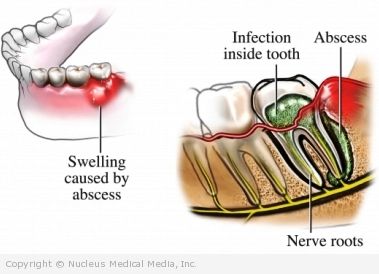Tooth abscess
(Dental Abscess; Abscessed Tooth)
Tooth abscess – Definition
A tooth abscess is a sac of pus (infected material) in a tooth or the gums. There are two types of tooth abscesses:
- Abscess of the pulp (blood and nerve supply inside the tooth)
- Abscess between the tooth and gum
Tooth abscess – Causes
Bacteria cause a tooth abscess. It begins when bacteria invade and infect a tooth. This results in pus build-up. When the pus is unable to drain, an abscess results.
Conditions that allow bacteria to invade a tooth:
- Severe tooth decay
- Break or crack in a tooth that lets bacteria invade the pulp
Food or other foreign matter that becomes trapped between the tooth and gum may lead to a bacterial infection in the area around the tooth.
Tooth abscess – Risk Factors
These factors increase your chance of developing a tooth abscess. Tell your dentist if you have any of these risk factors:
- Build up of tartar or calculus beneath the gum line
- Poor fluoride application to teeth via fluoridated water, toothpaste, or mouthwash
- Poor dental hygiene (leading to cavities and periodontal diseases)
- Malnutrition, including severe vitamin and mineral deficiencies
Tooth abscess – Symptoms
If you have any of these symptoms do not assume it is due to a tooth abscess. These symptoms may be caused by other conditions. Tell your dentist if you have any of these:
- Throbbing/lingering pain in a tooth or gum area
- Pain when biting on a tooth
- Spontaneous tooth pain
- Redness, tenderness, or swelling of the gums
- Fever
- Swollen neck glands
- Tooth discoloration
- Bad breath or foul taste in mouth
- Open, draining sore on the gums
If left untreated, complications of tooth abscess include:
- Loss of tooth and surrounding tissues or bone
- Spread of infection to surrounding tissue or bone
Tooth abscess – Diagnosis
Your dentist will ask about your symptoms and medical history and perform a detailed exam of your teeth and gums.
Your dentist will test the tooth for pain and sensitivity by:
- Lightly tapping on the tooth
- Stimulating the tooth nerve with heat or cold
- Stimulating the tooth nerve with a low electrical current
- Sliding a probe between the tooth and gum to measure gaps or tissue loss
Your dentist will also take an x-ray of the tooth and surrounding bone.
Tooth abscess – Treatment
Removal of Abscess Via Root Canal
If an abscess results from tooth decay or a break or crack in the tooth:
- The tooth and surrounding tissue is numbed and a hole is drilled through top of the tooth.
- Pus and dead tissue are removed from the center of the tooth.
- The interior of the tooth and the root (nerve) canals are cleaned and filled with a permanent filling.
- A crown is placed on the tooth to protect it.
If an abscess results from infection between the tooth and gum:
- The abscess is drained and thoroughly cleaned.
- The root surface of tooth is cleaned and smoothed.
- In some cases, surgery to reshape the gum is done to prevent recurrence of infection.
Tooth Extraction (Removal)
Removal of the tooth may be required if:
- Tooth decay and/or tooth infection is too extensive for filling or root canal treatment.
- The break or crack in the tooth is too severe to be repaired.
- The infection or loss of tissue/bone between the tooth and gum is severe.
If the tooth is extracted, it will be replaced with a:
- Partial bridge
- Denture
- Tooth implant
Medication
Antibiotics to fight residual infection of the tooth or gums
Nonprescription pain relief drugs (ibuprofen or acetaminophen) and warm salt water rinses
Tooth abscess – Prevention
To help reduce your chance of getting a tooth abscess, take the following steps:
- Proper dental hygiene, including:
- Brushing teeth with fluoride toothpaste after meals or at least twice per day
- Daily flossing between teeth and gums
- Regular dental check-ups (every six months)
- Regular professional teeth and gum cleaning (every six months)

